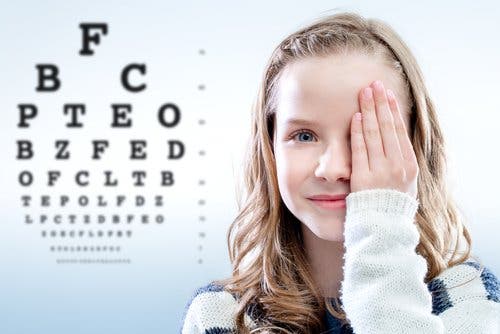The Adaptation of Materials for Students with Visual Disabilities


Written and verified by the psychologist Ana Couñago
Schools have the obligation of adapting materials for students with visual disabilities. That way, these children can access the academic curriculum and learning content.
This is a basic measure for meeting the specific educational support needs of students that experience significant visual difficulties.
“Just because a man lacks the use of his eyes doesn’t mean he lacks vision.”
– Stevie Wonder –
What is a visual disability?
Visual disabilities refer to the presence of significant functional deficiencies when it comes to sight. In other words, this concept includes different types of serious vision problems. So, according to Natalie Barraga, we can distinguish between:
- Total blindness: This type of vision only allows individuals to perceive light.
- Partial blindness: What little vision a person has only allows him or her to perceive blurry shapes or blobs.
- Low vision: Individuals experience important deficiencies when it comes to visual acuteness. However, they can see objects that are a few inches away. Therefore, they require adaptations to carry out a variety of day-to-day activities.
- Limited vision: The visual deficit isn’t excessively serious, meaning individuals aren’t unable to perform day-to-day activities. However, they do require certain simple adaptations in order to do so.

The adaptation of materials for children with visual disabilities
Children with visual disabilities need adapted materials to their special educational needs. This guarantees them proper access and reproduction of the information they must learn. These adaptations can take place using a variety of resources, including the following:
- Enlargement.
- Recordings.
- The Braille system.
- Tactile images.
Materials for students with visual disabilities: Enlargement
Enlargement consists of increasing the size of a document in order to facilitate access to specific material. The presentation should be clear and have good contrast with a letter-size that’s not too big.
This technique is useful only in specific cases, given that it’s best to use the adaptation possibilities that computers offer. That way, we can choose the most legible fonts for students with visual disabilities. And, at the same time, erase backgrounds and minimize poor contrasts.
Materials for students with visual disabilities: Recordings
Recordings are an excellent way to adapt academic materials for students with visual disabilities. This involves the oral transcription of materials so that children can access them by audio.
However, the main problem with this method is that it’s not possible to record everything. For example, content having to do with math, physics, chemistry, etc.
Materials for students with visual disabilities: The braille system
The braille system is a writing system that consists of raised points. Each letter or number is represented by a different combination of 6 points within a cell. Adapting materials for children with visual disabilities involves transcribing them to braille so that children can read them by touch
Materials for students with visual disabilities: Tactile images
Another way to adapt materials for children with disabilities that affect their vision is through the use of tactile images. These tools allow students to use their sense of touch in order to have an overall image of information.

- Size: Children should be able to access all of the information with their two hands and be able to discern it easily.
- Simplicity: It should be monothematic and include different textures and heights.
Other necessary adaptations
Besides the adaptation of visual materials, it’s also important to adapt a child’s environment. That means implementing a series of measures in regard to physical changes in the classroom and academic institution. For example:
- Providing students with visual disabilities with a desk that’s large enough for them to use their adapted materials.
- Organizing elements in a fixed and stable way, and always letting students know of any changes.
- Eliminating architectural obstacles and barriers that impede accessibility.
- Having proper lighting
Schools have the obligation of adapting materials for students with visual disabilities. That way, these children can access the academic curriculum and learning content.
This is a basic measure for meeting the specific educational support needs of students that experience significant visual difficulties.
“Just because a man lacks the use of his eyes doesn’t mean he lacks vision.”
– Stevie Wonder –
What is a visual disability?
Visual disabilities refer to the presence of significant functional deficiencies when it comes to sight. In other words, this concept includes different types of serious vision problems. So, according to Natalie Barraga, we can distinguish between:
- Total blindness: This type of vision only allows individuals to perceive light.
- Partial blindness: What little vision a person has only allows him or her to perceive blurry shapes or blobs.
- Low vision: Individuals experience important deficiencies when it comes to visual acuteness. However, they can see objects that are a few inches away. Therefore, they require adaptations to carry out a variety of day-to-day activities.
- Limited vision: The visual deficit isn’t excessively serious, meaning individuals aren’t unable to perform day-to-day activities. However, they do require certain simple adaptations in order to do so.

The adaptation of materials for children with visual disabilities
Children with visual disabilities need adapted materials to their special educational needs. This guarantees them proper access and reproduction of the information they must learn. These adaptations can take place using a variety of resources, including the following:
- Enlargement.
- Recordings.
- The Braille system.
- Tactile images.
Materials for students with visual disabilities: Enlargement
Enlargement consists of increasing the size of a document in order to facilitate access to specific material. The presentation should be clear and have good contrast with a letter-size that’s not too big.
This technique is useful only in specific cases, given that it’s best to use the adaptation possibilities that computers offer. That way, we can choose the most legible fonts for students with visual disabilities. And, at the same time, erase backgrounds and minimize poor contrasts.
Materials for students with visual disabilities: Recordings
Recordings are an excellent way to adapt academic materials for students with visual disabilities. This involves the oral transcription of materials so that children can access them by audio.
However, the main problem with this method is that it’s not possible to record everything. For example, content having to do with math, physics, chemistry, etc.
Materials for students with visual disabilities: The braille system
The braille system is a writing system that consists of raised points. Each letter or number is represented by a different combination of 6 points within a cell. Adapting materials for children with visual disabilities involves transcribing them to braille so that children can read them by touch
Materials for students with visual disabilities: Tactile images
Another way to adapt materials for children with disabilities that affect their vision is through the use of tactile images. These tools allow students to use their sense of touch in order to have an overall image of information.

- Size: Children should be able to access all of the information with their two hands and be able to discern it easily.
- Simplicity: It should be monothematic and include different textures and heights.
Other necessary adaptations
Besides the adaptation of visual materials, it’s also important to adapt a child’s environment. That means implementing a series of measures in regard to physical changes in the classroom and academic institution. For example:
- Providing students with visual disabilities with a desk that’s large enough for them to use their adapted materials.
- Organizing elements in a fixed and stable way, and always letting students know of any changes.
- Eliminating architectural obstacles and barriers that impede accessibility.
- Having proper lighting
All cited sources were thoroughly reviewed by our team to ensure their quality, reliability, currency, and validity. The bibliography of this article was considered reliable and of academic or scientific accuracy.
- Andrade, P. M. (2010). Alumnos con discapacidad visual Necesidades y respuesta educativa. Guía de orientación para la inclusión de alumnos con necesidades educativas especiales en el aula ordinaria.
- Barraga, N. (1985). Disminuciones visuales y aprendizaje. Madrid. ONCE. https://sid-inico.usal.es/idocs/F8/FDO23237/disminuidos_visuales_y_aprendizaje.pdf
- Flores, C., & Vilar, M. L. (2012). Producción de materiales didácticos para estudiantes con discapacidad visual. http://190.57.147.202:90/jspui/bitstream/123456789/742/1/produccion-discapacidad-visual.pdf
- López, I. M. y Valenzuela, G. E. (2015). Niños y adolescentes con necesidades educativas especiales. Revista Médica Clínica Las Condes, 26(1), 42-51.
- López, P. Z., & Perabá, C. M. (2021). Tiflotecnologías para el alumnado con discapacidad visual. ACADEMO Revista de Investigación en Ciencias Sociales y Humanidades, 8(1), 109-118. https://revistacientifica.uamericana.edu.py/index.php/academo/article/view/427/406
This text is provided for informational purposes only and does not replace consultation with a professional. If in doubt, consult your specialist.








